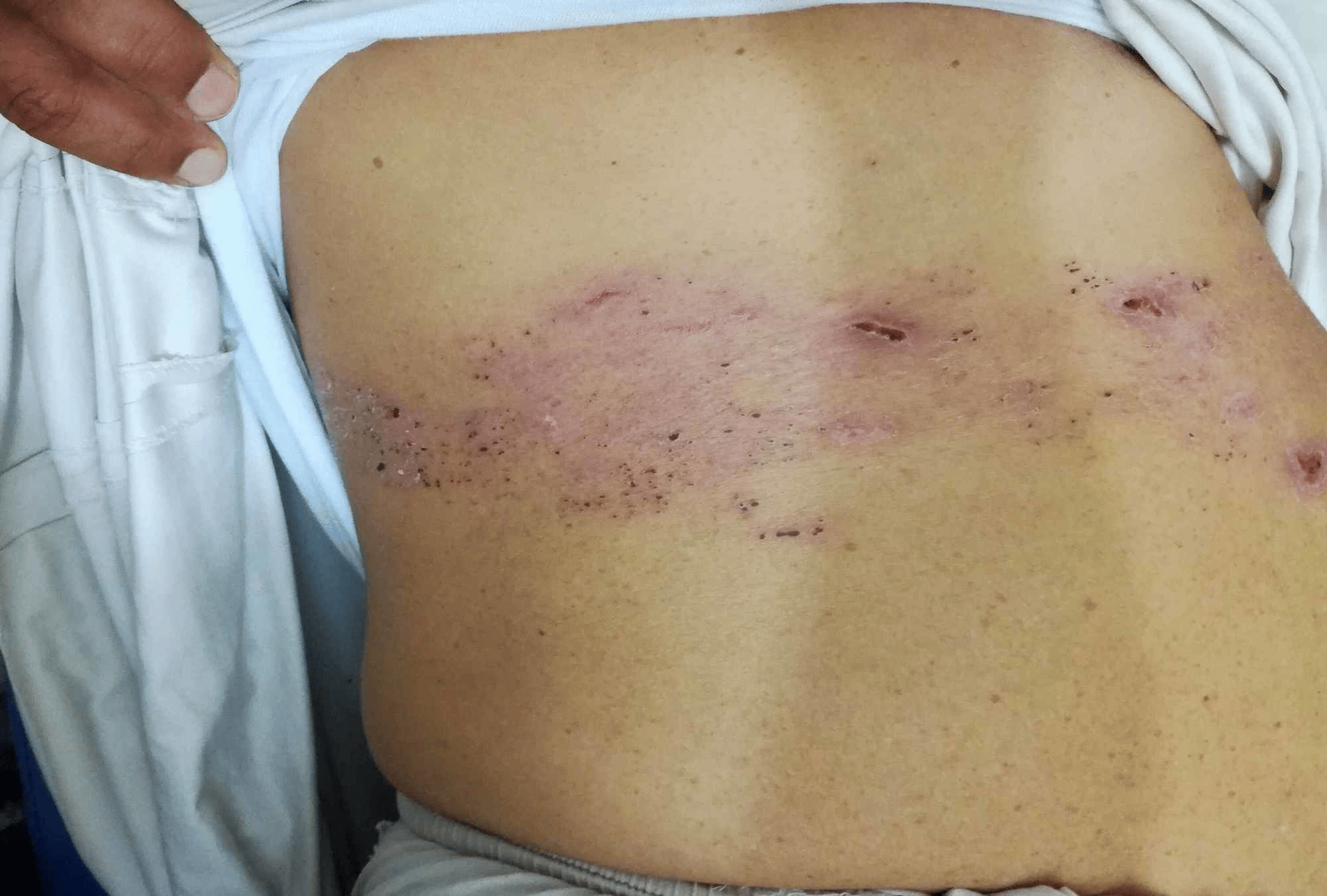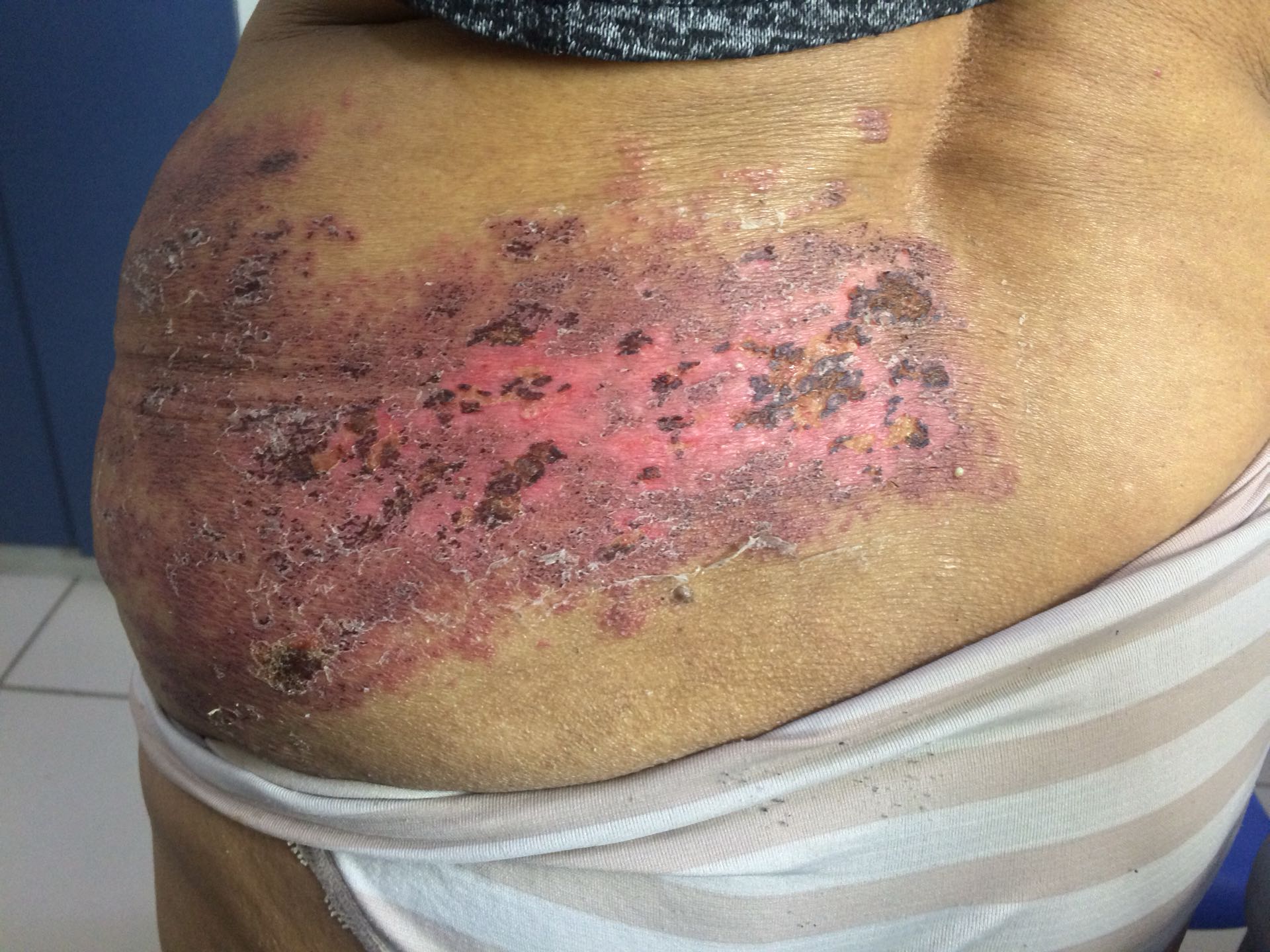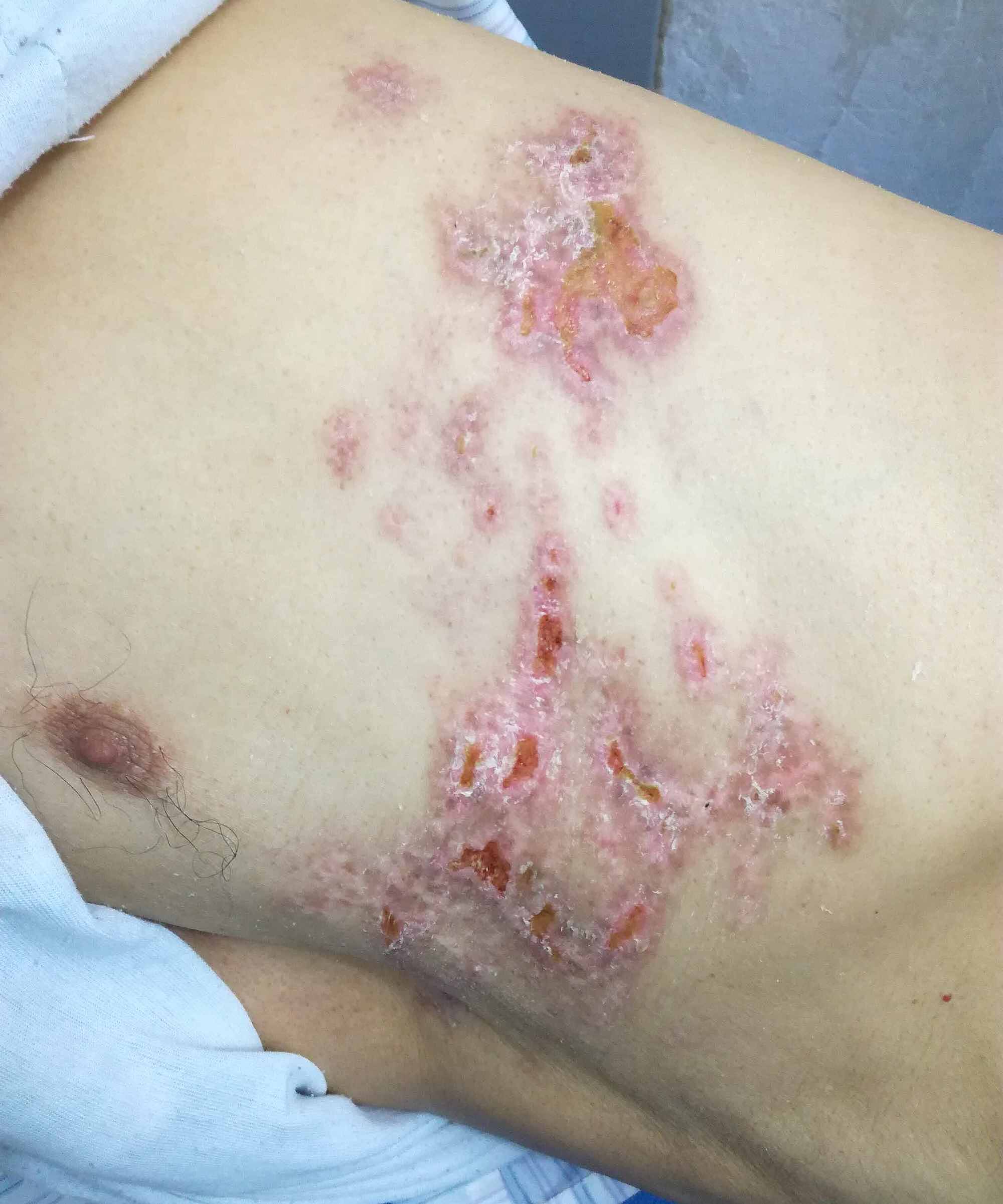What Causes Herpes Meningitis
Herpes meningitis is a viral meningitis, which means that the meningitis is caused by a virus.
A person may develop herpes meningitis if theyve contracted a herpes virus, including:
- Epstein-Barr virus , a common virus that causes mononucleosis and other illnesses
The viruses that cause herpes meningitis enter the body through your skin, where they can travel through the central nervous system and potentially cause problems in other parts of the body, like the tissues surrounding the CNS.
Once a herpes virus is in your system, it’s possible to get herpes meningitis at any time. That’s because the virus stays in your body for life and goes through periods of inactivity and flare-ups .
What Are The Symptoms Of Herpes Zoster
The rash associated with herpes zoster most often occurs on the trunk and buttocks. It may also appear on the arms, legs or face. While symptoms may vary child to child, the most common include:
- skin hypersensitivity in the area where the herpes zoster is to appear
- mild rash, which appears after five days and first looks like small, red spots that turn into blisters
- blisters, which turn yellow and dry, often leaving small, pitted scars
- rash goes away in one to two weeks
- rash is usually localized to one side of the body
Can You Get Shingles If You Havent Had Chickenpox
No. You cant get shingles if youve never had chickenpox, but you can get chickenpox from someone who has shingles. If youve never had chickenpox and you come into direct contact with the oozing, blister-like rash of someone with shingles, the varicella-zoster virus can infect you and you would develop chickenpox.
Once youve had chickenpox, you could develop shingles at some point in your life. This is because the varicella-zoster virus never fully goes away after youve had chickenpox. It lies quietly inactive in your nerve tissue. Later in life, the virus may become active again and appears as shingles.
Can you get chickenpox more than once?
Its rare to get chickenpox twice in your life. Once youve had chickenpox, youre usually immune to it for the rest of your life. However, its not totally impossible. If you have a severely weakened immune system , you can get chickenpox a second time. If youve had chickenpox, you are more likely to get shingles at some point in your life than a repeat bout of chickenpox.
Don’t Miss: How To Prevent Future Herpes Outbreaks
How Long Does A Shingles Outbreak Last
It can take three to five weeks from the time you begin to feel symptoms until the rash totally disappears.
Is The Zostavax Vaccine Still Being Used

Yes. The CDC, however, recommends Zostavax for adults age 60 and older, but not routinely for people aged 50 to 59. Zostavax is given as a single-dose shot versus the two-dose shot for Shingrix. Zostavax is less effective than Shingrix in preventing shingles and postherpetic neuralgia .
You can consider Zostavax if you are allergic to Shingrix or if Shingrix is unavailable because of supply shortage and you want some immediate protection from a possible case of shingles and/or postherpetic neuralgia. Because its a weakened live vaccine, it may be dangerous if you have cancer, HIV, or take steroids, chemotherapy or other medications that suppress your immune system. Ask your healthcare provider if the Zostavax vaccine is an option for you.
Recommended Reading: How Frequent Are Herpes Outbreaks In The First Year
Shingles On Your Face
Shingles usually occurs on one side of your back or chest, but you can also get a rash on one side of your face.
If the rash is close to or in your ear, it can cause an infection that could lead to:
- loss of hearing
- issues with your balance
- weakness in your facial muscles
Shingles inside your mouth can be very painful. It may be difficult to eat and may affect your sense of taste.
A shingles rash on your scalp can cause sensitivity when you comb or brush your hair. Without treatment, shingles on the scalp can lead to permanent bald patches.
Is Herpes Zoster Common
Herpes zoster is more common in people with a depressed immune system and those over the age of 50. It’s quite rare in children and the symptoms are mild compared to what an adult may experience. Children most at risk for herpes zoster are those who had chicken pox during the first year of life or whose mothers had chicken pox very late during pregnancy.
Don’t Miss: Has Herpes Ever Been Cured
Uncommon Rare And Very Rare Adverse Events
Uncommon adverse events occur in 0.1% to less than 1% of vaccinees. Rare and very rare adverse events occur, respectively, in 0.01% to less than 0.1% and less than 0.01% of vaccinees.
Both HZ vaccines are safe with serious adverse events reported very rarely in immunocompetent individuals.
Recurrence or exacerbation of herpes zoster ophthalmicus following LZV vaccination has been reported very rarely, involving several cases world-wide following LZV immunization. Following a causality assessment of seven cases of HZO which were temporally associated with the administration of LZV, NACI concluded that there was insufficient evidence to recommend for or against the administration of LZV in individuals with a history of HZO. More evidence is required for further assessment of risk related to HZO recurrence in LZV recipients. At this time, there is insufficient evidence to assess the risk related to HZO recurrence following RZV recipients.
See Contraindications and Precautions if considering vaccinating a person with previous HZO.
For more information, refer to Adverse Events Following Immunization in Part 2 and the product monograph in Health Canada’s Drug Product Database.
How Can I Take Care Of Myself
- Take a pain-relief medicine such as acetaminophen. Take other medicine as prescribed by your healthcare provider.
- Put cool, moist washcloths on the rash.
- Rest in bed during the early stages if you have fever and other symptoms.
- Try not to let clothing or bed linens rub against the rash and irritate it.
- You develop worsening pain or fever.
- You develop a severe headache, stiff neck, hearing loss, or changes in your ability to think.
- The blisters show signs of bacterial infection, such as increasing pain or redness, or milky yellow drainage from the blister sites.
- The blisters are close to the eyes or you have pain in your eyes or trouble seeing.
- You have trouble walking.
You May Like: What Test Is Done For Herpes
Who Is Most At Risk Of Getting Shingles
Although any person who has had chickenpox can get shingles, most people who do so are older than 50 or have a weakened immune system. For example, a person might be susceptible if they have cancer, take medicines that weaken their immune system, or have HIV or AIDS, even if they are younger than 50.
What Precautions Are Taken In The Hospital If I Have Herpes Zoster
Isolation precautions are steps we take to stop infections from spreading from person to person. If youre diagnosed with or exposed to chickenpox while youre in the hospital:
- You will be placed in a private room.
- The door to your room must remain closed at all times.
- A sign will be posted on your door telling all staff to clean their hands with soap and water or an alcohol-based hand sanitizer before going into and after leaving your room.
- Isolation precautions for localized and disseminated herpes zoster are different.
- For localized herpes zoster, all staff must wear a yellow gown and gloves in your room. These are available outside of your room and can be disposed of inside your room.
- For disseminated herpes zoster, staff must wear a yellow gown, gloves, and a respirator mask while in your room.
- You cant walk around in the unit while following these isolation precautions.
You can stop following these precautions when all your blisters are dried and crusted.
Recommended Reading: How Long Does It Take To Treat Herpes
What Are The Risks Associated With Shingles
Some people experience pain around the rash site for a month or morepain that is severe enough to interfere with daily activities.
Scratching the rash can also cause a secondary infection if harmful bacteria get into the sores.
Shingles on the face can involve the eyes, which is serious because it can cause scarring and blindness.
The occurrence and severity of shingles and its complications increase with age.
What Are The Clinical Features Of Herpes Zoster

Herpes zoster is characterised by dermatomaldistribution, that is the blisters are confined to the cutaneous distribution of one or two adjacent sensory nerves. This is usually unilateral, with a sharp cut-off at the anterior and posterior midlines.
The clinical presentation of herpes zoster depends on the age and health of the patient and which dermatome is affected.
The first sign of herpes zoster is usually localised pain without tenderness or any visible skin change. It may be severe, relating to one or more sensory nerves. The pain may be just in one spot, or it may spread out. The patient may feel quite unwell with fever and headache. The lymph nodes draining the affected area are often enlarged and tender.
Within one to three days of the onset of pain, a blistering rash appears in the painful area of skin. It starts as a crop of red papules. New lesions continue to erupt for several days within the distribution of the affected nerve, each blistering or becoming pustular then crusting over.
The chest , neck , forehead and lumbar/sacral sensory nerve supply regions are most commonly affected at all ages. The frequency of ophthalmic herpes zoster increases with age. Herpes zoster occasionally causes blisters inside the mouth or ears, and can also affect the genital area. Sometimes there is pain without rashherpes zoster “sine eruptione”or rash without pain, most often in children.
Herpes zoster
Read Also: How Can I Get Herpes 1
Do You Need To Stay Away From Children People Who Are Pregnant Have Cancer Or Anyone With A Weak Immune System After You Get The Zostavax Vaccine
According to the CDC, its safe to be around babies and young children, pregnant women or anyone with a weakened immune system after you get the Zostavax vaccine. Even though the Zostavax vaccine contains a weakened live varicella-zoster virus, the CDC says theres no documented case of a person getting chickenpox from someone who has received the Zostavax vaccine. And remember: You cant get shingles unless youve already had chickenpox.
What Are The Symptoms Of Shingles
Early symptoms of shingles may include:
Other signs and symptoms that appear a few days after the early symptoms include:
- An itching, tingling or burning feeling in an area of your skin.
- Redness on your skin in the affected area.
- Raised rash in a small area of your skin.
- Fluid-filled blisters that break open then scab over.
- Mild to severe pain in the area of skin affected.
Also Check: How Do You Get Herpes 1
How Common Is Herpes Meningitis
Because herpes meningitis often resolves on its own, not all cases are recorded, so it’s unclear exactly how common it is. For some perspective, older data show that tens of thousands of meningitis-related hospitalizations in the United States are due to a virus like a herpes virus. Experts believe most cases of herpes meningitis are caused by HSV-2, which is present in roughly 12% of U.S. adults under age 50.
Symptoms And Signs Of Herpes Zoster
Lancinating, dysesthetic, or other pain develops in the involved site, typically followed within 2 to 3 days by a rash, usually crops of vesicles on an erythematous base. The site is usually one or more adjacent dermatomes in the thoracic or lumbar region, although a few satellite lesions may also appear. Lesions are typically unilateral and do not cross the midline of the body. The site is usually hyperesthetic, and pain may be severe. Lesions usually continue to form for about 3 to 5 days.
Herpes zoster may disseminate to other regions of the skin and to visceral organs, especially in immunocompromised patients.
Ophthalmic herpes zoster Herpes Zoster Ophthalmicus Herpes zoster ophthalmicus is a reactivated latent varicella-zoster virus infection involving the eye. Symptoms and signs, which may be severe, include unilateral dermatomal… read more results from involvement of the gasserian ganglion, with pain and vesicular eruption around the eye and on the forehead, in the V1 distribution of the ophthalmic division of the 5th cranial nerve. Ocular disease can be severe. Vesicles on the tip of the nose indicate involvement of the nasociliary branch and a higher risk of severe ocular disease. However, the eye may be involved in the absence of lesions on the tip of the nose.
Intraoral zoster is uncommon but may produce a sharp unilateral distribution of lesions. No intraoral prodromal symptoms occur.
You May Like: How To Treat Herpes On Your Lip
Is There A Treatment For Shingles
Several antiviral medicines, acyclovir , valacyclovir , and famciclovir , are available to treat shingles. These medications should be started as soon as possible after the rash appears and will help shorten the illness and decrease how severe the illness is. Pain medicine may also help with pain caused by shingles. Call your provider as soon as possible to discuss treatment options.
What Are The Complications Of Shingles
After the shingles rash has disappeared, you might continue to have nerve pain in that same area. Postherpetic neuralgia can last for months or years and become quite severe.
More than 10% of people who get shingles develop postherpetic neuralgia. Researchers dont know why some people get postherpetic neuralgia and others dont. It may be that nerves become more sensitive or that the virus may be invading and damaging the central nervous system.
Other complications include:
- Other types of nerve issues like numbness or itching.
- A bacterial infection of the shingles rash.
- Eye and ear inflammation if the rash is near these organs.
Also Check: L Lysine For Genital Herpes
Is There Any Way To Prevent Herpes Zoster
There is a vaccine called Shingrix® that prevents herpes zoster. This vaccine is recommended for people 50 years of age and older. It is also recommended for adults with weakened immune systems who are over the age of 19. Talk to your healthcare provider for more information about this vaccine.
What Are The Complications Associated With Shingles

Shingles is not usually dangerous to healthy individuals although it can cause great misery during an attack. Anyone with shingles on the upper half of their face, no matter how mild, should seek medical care at once because of the risk of damage to the eye. Very rarely, shingles can lead to pneumonia, hearing problems, blindness, brain inflammation or death. For about one person in five, severe pain can continue even after the rash clears up. This pain is called post-herpetic neuralgia. As people get older, they are more likely to develop post-herpetic neuralgia, and it is more likely to be severe.
Also Check: Is Genital Herpes Contagious All The Time
Healthcare Personnel Who Have 1 Or More Documented Dose Of Varicella Vaccine Or Other Evidence Of Immunity To Varicella:
- Do not need postexposure prophylaxis
- Do not need work restrictions
- Should ensure they are up to date with 2 documented doses of varicella vaccine.
- If they have only 1 documented dose of varicella vaccine, they should receive the second dose within 3 to 5 days after exposure, as long as 4 weeks have elapsed since the first dose.
- Should self-monitor, or have the employee health program or an infection control nurse monitor, during days 8 to 21 after exposure and immediately report any fever, headache, skin lesions, or systemic symptoms.
- If symptoms occur, immediately remove healthcare personnel from patient care, place them on sick leave, and provide them with antiviral medication if symptoms occur
Is There A Vaccine For Shingles
There are two shingles vaccines currently available, Shingrix and Zostavax. Shingrix vaccine, a newer vaccine, is preferred over Zostavax for the prevention of shingles and its complications. Two doses of Shingrix given 2 to 6 months apart are recommended for healthy adults 50 years of age and older. Shingrix is also recommended for adults who have previously received Zostavax. A single dose of Zostavax may still be used to prevent shingles in certain cases for healthy adults 60 years and older.
Recommended Reading: Can Herpes Come And Go
Can You Get Chickenpox If You’ve Been Vaccinated
Yes. About 15% 20% of people who have received one dose of varicella vaccine do still get chickenpox if they are exposed, but their disease is usually mild. Vaccinated persons who get chickenpox generally have fewer than 50 spots or bumps, which may resemble bug bites more than typical, fluid-filled chickenpox blisters. In 2006, the Advisory Committee on Immunization Practices voted to recommend routine two-dose varicella vaccination for children. In one study, children who received two doses of varicella vaccine were three times less likely to get chickenpox than individuals who have had only one dose.